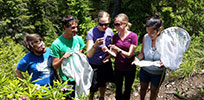Bumble Bee Conservation
![]()
Bumble bees are important pollinators of wild flowering plants and agricultural crops. They are able to fly in cooler temperatures and lower light levels than many other bees, making them excellent pollinators – especially at higher elevations and latitudes. They also perform a behavior called “buzz pollination,” in which the bee grabs the flower in her jaws and vibrates her wing muscles to dislodge pollen from the flower. Many plants, including a number of wildflowers and crops like tomatoes, peppers, and cranberries, benefit from buzz pollination.
Because they are essential pollinators, loss of bumble bees can have far ranging ecological consequences. Alarmingly, recent work by the Xerces Society in concert with IUCN Bumble Bee Specialist Group, indicates that some species have experienced rapid and dramatic declines more than others. In fact, more than one quarter (28%) of all North American bumble bees are facing some degree of extinction risk. While some species have received considerable conservation attention, other species such as the Suckley cuckoo bumble bee and the variable cuckoo bumble bee have been largely overlooked.
For information about our efforts to conserve the rusty patched bumble bee (Bombus affinis), please see its’ profile page; to interact with the history of the rusty patched bumble bee check out the story map.
Key Threats
Bumble bees face many threats including habitat loss, disease, pesticide use, and climate change. Unlike honeybees which have large (>10,000 individuals) perennial hives, bumble bees produce smaller annual colonies (50-1,500 individuals). Due to their smaller annual population sizes, life cycle, and genetic makeup, they are uniquely susceptible to extinction.
 Bumble bees commercially reared for agriculture are transmitting diseases to wild populations.
Bumble bees commercially reared for agriculture are transmitting diseases to wild populations. One of the biggest factors affecting all pollinators is fragmentation and loss of habitat.
One of the biggest factors affecting all pollinators is fragmentation and loss of habitat. Climate change is affecting bumble bees by changing bloom time and subjecting populations to fluctuating temperatures and weather extremes.
Climate change is affecting bumble bees by changing bloom time and subjecting populations to fluctuating temperatures and weather extremes.Learn More
Protecting Bumble Bees
Learn what the Xerces Society is doing to preserve and protect at-risk bumble bee species. Learn more
Species At-Risk
Working with experts in the IUCN Bumblebee Specialist Group, the Xerces Society has completed research to better understand the extinction risk of all North American bumble bees. Learn more
Learn About Bumble Bees
Learn about the life cycle, foraging, and pollination techniques that make bumble bees truly unique! Learn more
Get Involved

Report a Sighting
Join thousands of citizen scientists across North America in recording your sightings through Bumble Bee Watch. Snap a photo, submit it online, and help us track bumble bee populations in the U.S. and Canada.

Become a Habitat Steward
Use our bumble bee conservation guidelines and companion brochure to learn how to manage natural areas for bumble bees. Use our Pollinator Conservation Resource Center to find plant lists, guidelines, and fact sheets to create habitat in your garden or on your farm. Be sure to sign the pledge to help Bring Back the Pollinators!

Host or Attend an Event
The Xerces Society works with many agencies and organizations to train land managers, citizen scientists, farmers and gardeners on pollinator conservation issues, including bumble bee monitoring and I.D. workshops. Contact us to host an event near you.
Resources
Conserving Bumble Bees
Creating, protecting and restoring habitat is a very important way to conserve the populations of bees that remain. To help landowners and managers achieve this, the Xerces Society for Invertebrate Conservation published Conserving Bumble Bees. Guidelines for Creating and Managing Habitat for America’s Declining Pollinators.
Bumble Bee Conservation Brochure
This brochure contains information about how to enhance any landscape to help meet the seasonal needs of bumble bees. View or download as a PDF.
IUCN Bumble Bee Specialist Group
The Bumblebee Specialist Group is working towards a comprehensive and detailed assessment of the global status of bumble bees, including a major red listing effort for all species, as well as promoting their conservation. Click here to read more.
Learn About Bumble Bees
Learn about the life-cycle of bumble bees, how to ID them, download pocket guides, and use interactive resources. Read more.
A Ghost in the Making
Natural history photographer Clay Bolt is on a multi-year quest to tell the stories of our native bees, and one elusive species – the Rusty-patched Bumble Bee – has become his white whale. In January of 2013, the Xerces Society and partners filed a petition to list the rusty patched bumble bee as an endangered species under the US Endangered Species Act.
The film from Day’s Edge Productions and acclaimed nature photographer Clay Bolt illuminates the challenges faced by the critically endangered species. In conjunction with the film’s release, a change.org petition urging the US Fish and Wildlife Service to add the rusty patched bumble bee as an endangered species under the U.S. Endangered Species Act has gained over 125k signatures.
You may view the full-length film below, and find out more at rustypatched.com








